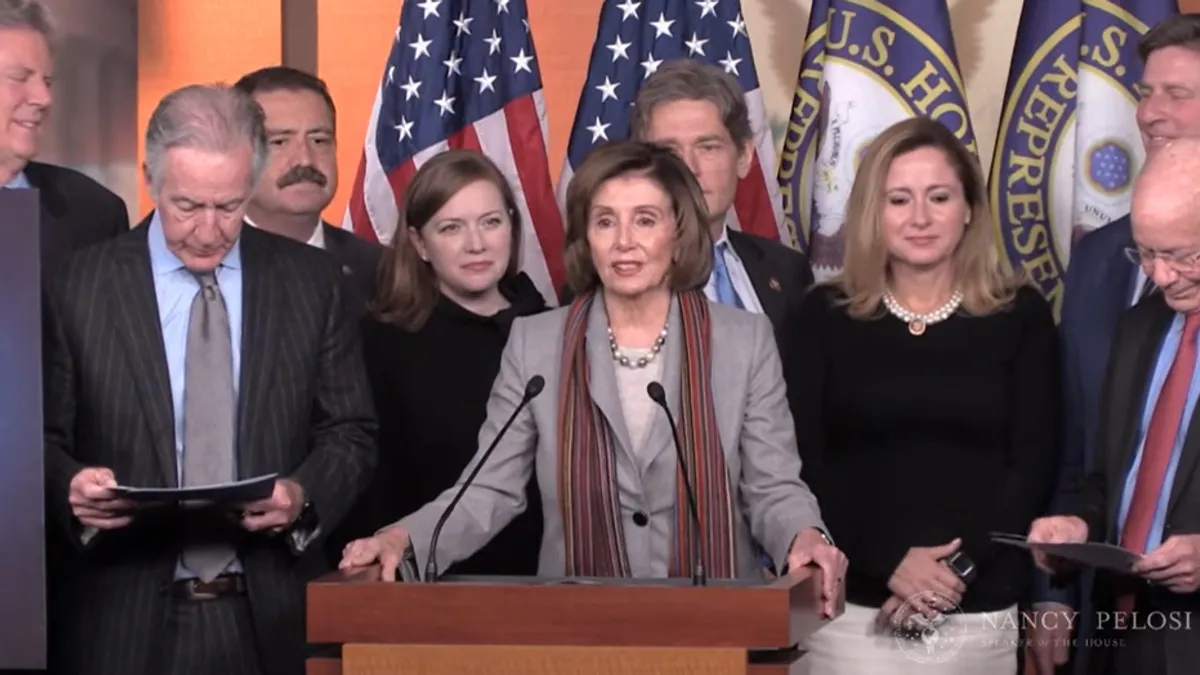Dive Brief:
- House Democrats on Wednesday unveiled a $760 billion infrastructure blueprint, saying the framework would address the country's maintenance backlog as well as cut emissions in the transportation sector. Democrats said the plan, the Moving Forward Framework, would create more than 10 million jobs.
- The proposal would invest $329 billion to modernize bridges and highways, and would increase the amount of alternative fueling options like electric vehicle (EV) chargers available. It also calls for a $105 billion investment in transit and $55 billion in rail, and a $86 billion investment to improve broadband internet access to unserved and underserved areas. The plan also invests in a slew of other areas, including water infrastructure, wastewater, harbors, airports, public safety communications and clean energy.
- At a press conference, Democratic leaders declined to say how they would foot the bill, instead calling on President Trump to state publicly his preference on a funding source. "I think it's really important that we not volunteer a revenue stream until the administration reaches an agreement with us," Rep. Richard Neal, D-Mass., who chairs the House Ways and Means Committee, said.
Dive Insight:
Federal infrastructure investment has bedeviled lawmakers for some time, including in 2018 when President Trump released his first proposal but saw it get gummed up in Congress, to the frustration of city leaders. Trump's own plan would have relied heavily on public-private partnerships (P3s), whereas this one might call for a major increase in federal spending.
A major stumbling block has been how to finance any infrastructure proposal. While polling shows people are willing to pay more in taxes and tolls to support improvements and cut congestion, Congress has been unable to reach an agreement despite local action and apparent willingness to raise taxes as a way to find revenues.
Despite financial barriers, statements of support noted the economic impact of infrastructure investment. Business Roundtable cited a recent study that found every dollar invested in infrastructure delivers roughly $3.70 in additional economic growth over 20 years. Investment, the group said, would "turn one of America's economic weaknesses into an economic strength."
Democratic leaders emphasized that a key part of their infrastructure proposal is the need to bring emissions down and fight against climate change. Transportation is one of the highest-emitting sectors, and the need for resilience is heightened as climate change brings more and more extreme weather events.
By placing sustainability at the heart of their plan, Democrats said they can tackle a number of major issues at once. "There's so many ways we can deal with our climate crisis by solving our congestion and infrastructure crisis," Rep. Peter DeFazio, D-OR, chair of the House Transportation and Infrastructure Committee, said during the press conference.
This new blueprint also includes a pledge to make use of new and innovative technologies in transportation. Shailen Bhatt, president and CEO of the Intelligent Transportation Society of America (ITS America) said in a statement that his organization "supports congressional efforts that recognize the added value of integrating technology into transportation infrastructure and providing funding for the rapid deployment of technologies across the country."
House Speaker Nancy Pelosi said the plan had been put together with the help of the nation's mayors, who have consistently said that investing in infrastructure is a key priority for them. "Everybody is going to be at the table as we go forward, as everybody is affected by this," Pelosi said during the press conference.
National League of Cities President and Los Angeles City Councilmember Joe Buscaino said in a statement that the blueprint shows "leading with urgency" considering the backlog of needs.
Action on #infrastructure today out of #Washington! Local leaders across this country are encouraged to see a fresh approach and stronger support from Congress to rebuild our nation's #transportation #water #workforce & other infrastructure needs #RebuildWithUs @JoeBuscaino pic.twitter.com/pTNPmejWVI
— National League of Cities (@leagueofcities) January 29, 2020
And in a joint statement, advocacy groups Transportation for America and the National Complete Streets Coalition said the emphasis on safety and plans to "leave the status quo behind" are strong suggestions.
"For the last 40 years, lawmakers have largely focused on pouring more money into a broken federal program that fails to hold states accountable for maintaining our infrastructure, produces more congestion, makes safety secondary, and fails to affordably and efficiently connect us to the things we need," the groups said. "It's high time to stop spending billions on a broken system, and these principles would be a transformative guide as Congress crafts a transportation law to serve the country's greatest needs."
But political realities are never far away. In a statement of his own, Rep. Sam Graves, R-Mo., the ranking member on the House Transportation and Infrastructure Committee, called for a "bipartisan process" as opposed to recent "partisan posturing," and said that while he "may not agree with all of the principles in the majority's outline," he expects to play a "constructive role" in any infrastructure package.















